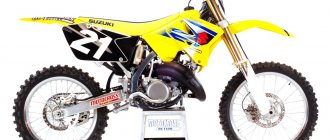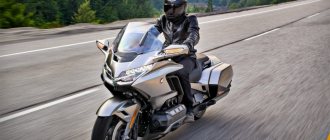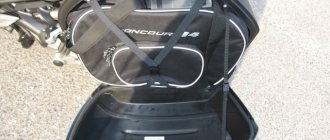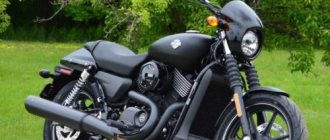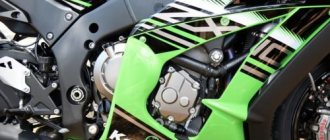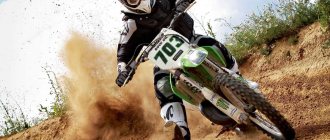| Kawasaki KX85-I (KX85-A), 2001-2013 | Kawasaki KX85-II (KX85-B), 2001-2013 | Kawasaki KX85-I (KX85-C), 2014+ | Kawasaki KX85-II (KX85-D), 2014+ |
the Kawasaki KX 85 motocross motorcycle
produced from 2001 to the present. This model is sports equipment for learning motocross for children and teenagers. The Kawasaki KX 85 features a steel frame, a powerful 2-stroke engine, KIPS (Integrated Power Valve System) and long-travel sports suspensions. An important advantage of this motorcycle is the price, which allows you to get an excellent device for gaining initial motocross skills for little money.
Main modifications:
- Kawasaki KX 85-I
- the modification is distinguished by 17′ (front) and 14′ (rear) wheels. - Kawasaki KX 85-II
- the modification is distinguished by 19′ (front) and 16′ (rear) wheels.
The main feature of the Kawasaki KX 85 is a 1-cylinder, 2-stroke, liquid-cooled engine with a capacity of 84 cc. see, producing 28.5 hp. power and 17.2 Nm of torque. The presence of the KIPS power valve system allows you to obtain a variable engine compression ratio, which depends on the operating speed. All this significantly smoothes the power curve and increases traction at low revs.
In 2014, the model undergoes a slight restyling, receiving updated suspension settings, engine settings (KIPS settings), overall dimensions, braking system (petal discs of increased diameter), fuel tank (became smaller by 0.5 liters) and new plastic elements.
The “older” brother of the model is the Kawasaki KX 125.
The main competitors of the Kawasaki KX 85 in the class:
- Honda CR 85
- Suzuki RM 85
- Yamaha YZ 85
Brief history of the model
- 2001 - start of production and sales. First generation.
Model
: Kawasaki KX85: : Kawasaki KX85-II (North America, Europe, Australia, Japan).
Factory designation:
KX85-A1; KX85-B1.
- 2002 - no significant changes.
Model
: Kawasaki KX85: : Kawasaki KX85-II (North America, Europe, Australia, Japan).
Factory designation:
KX85-A2; KX85-B2.
- 2003 - no significant changes.
Model
: Kawasaki KX85: : Kawasaki KX85-II (North America, Europe, Australia, Japan).
Factory designation:
KX85-A3; KX85-B3.
- 2004 - no significant changes.
Model
: Kawasaki KX85: : Kawasaki KX85-II (North America, Europe, Australia, Japan).
Factory designation:
KX85-A4; KX85-B4.
- 2005 - no significant changes.
Model
: Kawasaki KX85: : Kawasaki KX85-II (North America, Europe, Australia, Japan).
Factory designation:
KX85-A5; KX85-B5.
- 2006 - no significant changes.
Model
: Kawasaki KX85: : Kawasaki KX85-II (North America, Europe, Australia, Japan).
Factory designation:
KX85-A6F; KX85-B6F.
- 2007 - no significant changes.
Model
: Kawasaki KX85: : Kawasaki KX85-II (North America, Europe, Australia, Japan).
Factory designation:
KX85-A7F; KX85-B7F.
- 2008 - no significant changes.
Model
: Kawasaki KX85: : Kawasaki KX85-II (North America, Europe, Australia, Japan).
Factory designation:
KX85-A8F; KX85-B8F.
- 2009 - no significant changes.
Model
: Kawasaki KX85: : Kawasaki KX85-II (North America, Europe, Australia, Japan).
Factory designation:
KX85-A9F; KX85-B9F.
- 2010 - no significant changes.
Model
: Kawasaki KX85: : Kawasaki KX85-II (North America, Europe, Australia, Japan).
Factory designation:
KX85-AAF; KX85-BAF.
- 2011 - no significant changes.
Model
: Kawasaki KX85: : Kawasaki KX85-II (North America, Europe, Australia, Japan).
Factory designation:
KX85-ABF; KX85-BBF.
- 2012 - no significant changes.
Model
: Kawasaki KX85: : Kawasaki KX85-II (North America, Europe, Australia, Japan).
Factory designation:
KX85-ACF; KX85-BCF.
- 2013 - no significant changes.
Model
: Kawasaki KX85: : Kawasaki KX85-II (North America, Europe, Australia, Japan).
Factory designation:
KX85-ADF; KX85-BDF.
- 2014 - restyling of the model. Second generation
.
Model
: Kawasaki KX85: : Kawasaki KX85-II (North America, Europe, Australia, Japan).
Factory designation:
KX85-CEF; KX85-DEF.
- 2015 - no significant changes.
Model
: Kawasaki KX85: : Kawasaki KX85-II (North America, Europe, Australia, Japan).
Factory designation:
KX85-CFF; KX85-DFF.
- 2016 - no significant changes.
Model
: Kawasaki KX85: : Kawasaki KX85-II (North America, Europe, Australia, Japan).
Factory designation:
KX85-CGF; KX85-DGF.
- 2017 - no significant changes.
Model
: Kawasaki KX85: : Kawasaki KX85-II (North America, Europe, Australia, Japan).
Factory designation:
KX85-CHF; KX85-DHF.
- 2018 - no significant changes.
Model
: Kawasaki KX85: : Kawasaki KX85-II (North America, Europe, Australia, Japan).
Factory designation:
KX85-CJF; KX85-DJF.
- 2019 - no significant changes.
Model
: Kawasaki KX85: : Kawasaki KX85-II (North America, Europe, Australia, Japan).
Factory designation:
KX85-CKF; KX85-DKF.
- 2020 - no significant changes.
Model
: Kawasaki KX85: : Kawasaki KX85-II (North America, Europe, Australia, Japan).
Factory designation:
KX85-CLF; KX85-DLF.
- 2021 - no significant changes.
Model
: Kawasaki KX85: : Kawasaki KX85-II (North America, Europe, Australia, Japan).
Factory designation:
KX85CMFNN; KX85DMFNN.
- 2022 - no significant changes.
Model
: Kawasaki KX85: : Kawasaki KX85-II (North America, Europe, Australia, Japan).
Factory designation:
KX85CNFNN; KX85DNFNN.
Specifications
Technical characteristics of Kawasaki KX85 (KX85-II):
| Model | Kawasaki KX85 |
| Motorcycle type | cross |
| Year of issue | 2001+ |
| Frame | steel half-duplex |
| engine's type | 1-cylinder, 2-stroke |
| Working volume | 84 cm³ |
| Bore/Stroke | 48.5 x 45.8 mm |
| Compression ratio | 10.0:1 (low speed), 9.2:1 (high speed) – KX85-A, KX85-B 10:9 (low speed), 9.0:1 (high speed) – KX85-C, KX85-D |
| Cooling | liquid |
| Number of valves per cylinder | power valve system (KIPS) |
| Fuel supply system | Carburetor, 1x Keihin PWK28 |
| Ignition type | CDI |
| Maximum power | 28.5 hp (21.0 kW) at 12000 rpm |
| Maximum torque | 17.2 Nm (1.8 kg*m) at 11000 rpm |
| Transmission | 6-speed |
| type of drive | chain |
| Front tire size | 70/100-17 40M – KX85-A, KX85-C 70/100-19 42M – KX85-B, KX85-D |
| Rear tire size | 90/100-14 49M – KX85-A, KX85-C 90/100-16 52M – KX85-B, KX85-D |
| Front brakes | 1 disc, 202 mm, 2-piston caliper – KX85-A, KX85-B 1 disc, 220 mm, 2-piston caliper – KX85-C, KX85-D |
| Rear brakes | 1 disc, 150 mm, 1-piston caliper – KX85-A, KX85-B 1 disc, 184 mm, 1-piston caliper – KX85-C, KX85-D |
| Front suspension | 36 mm inverted fork (20-step compression adjustment), travel - 275 mm |
| Rear suspension | Pendulum progressive Uni-Trak with monoshock absorber (fully adjustable), travel - 275 mm |
| Motorcycle length | 1820 mm – KX85-A 1910 mm – KX85-B 1830 mm – KX85-C 1920 mm – KX85-D |
| Motorcycle width | 735 mm – KX85-A, KX85-B 765 mm – KX85-C, KX85-D |
| Motorcycle height | 1055 mm – KX85-A 1105 mm – KX85-B 1100 mm – KX85-C 1150 mm – KX85-D |
| Wheelbase | 1255 mm – KX85-A 1290 mm – KX85-B 1265 mm – KX85-C 1310 mm – KX85-D |
| Seat height | 840 mm – KX85-A 870 mm – KX85-B, KX85-D 830 mm – KX85-C |
| Minimum ground clearance (clearance) | 340 mm – KX85-A 380 mm – KX85-B 290 mm – KX85-C 330 mm – KX85-D |
| Acceleration 0-100 km/h (0-60 mph) | |
| Maximum speed | |
| Gas tank capacity | 5.5 l – KX85-A, KX85-B 5.0 l – KX85-C, KX85-D |
| Motorcycle weight (dry) | 65 kg – KX85A1-A8F 69 kg – KX85A9F-ADF 68 kg – KX85B1-B8F 71 kg – KX85B9F-BDF |
| Motorcycle weight (curb) | 75 kg – KX85-C, KX85-D |
Specifications for Kawasaki KX 80
One of Kawasaki's long-lived small motorcycles, the KX 80, debuted in 1979 and remained in production for over 20 years. The bike was designed for children and had a smaller frame and less powerful engine than adult Kawasaki motorcycles. However, it provided decent speed, agility and agility on course.
Dimensions and capacity
The 2000 KX 80 weighed just 143 pounds, making it well suited for young and small riders but impractical for larger users. It was 71.6 inches long, 28.9 inches wide, and 41.5 inches high. Its wheelbase was 49.4 inches. The KX 80 had a relatively high ground clearance of 13.4 inches, which improved maneuverability on uneven surfaces. The bike could carry 1.46 gallons of fuel.
engine
The 2000 KX 80 was equipped with an 82cc two-stroke, single-cylinder engine. See with piston reed switch. The engine had a bore and stroke of 1.89 inches by 1.80 inches, and a compression ratio of 10.3 to 1 at low speeds and 9.4 to 1 at high speeds.
systems
A Keihin PE 26 carburetor, 32-to-1 lubrication system and liquid cooling system worked in conjunction with the engine. The 2000 KX 80 also had a primary kick starter and capacitive discharge ignition. The bike took the NGK R6252K-105 spark plugs into a rugged post terminal.
Transmission
The 2000 KX 80 was equipped with a six-speed constant mesh transmission with reverse shifting and chain drive. It also featured a wet, multi-plate clutch. In addition, the bike took SAE 10W30 or 10W40 gear oil, grade SE, SF or SG.
Chassis and suspension
Built on a tubular frame with a single drop tube, the KX 80 had a 27-degree rake angle, 45-degree rake angle both ways and a 3.50-inch trail. At the front, it had a telescopic fork with 10.83 inches of travel. The rear of the bike featured Uni-trak suspension that could travel 10.83 inches.
Brakes and Tires
The KX 80 was equipped with 7.95-inch front and 5.91-inch rear disc brakes front and rear. It also had standard Dunlop tires, size 70/100-17 40M front and 90/100-14 49M rear.
Related articles:
- 2001 Kawasaki Mule 3010 4x4 Specifications
- Technical characteristics of Yamaha TTR 250
- 2003 Yamaha TT-R 125 Specifications
- Kawasaki Bayou 400 Specifications
- Honda XR100R Specifications
- 1995 KX 80 Engine Specs
Reviews
Reviews about Kawasaki KX 85:
Kawasaki KX85 motocross motorcycle for beginner motocross riders. If your child has already mastered 50 cc models and you decide that it’s time to move on to a more powerful motorcycle, then the Kawasaki KX85 is ideal because... Despite the small engine size, it has phenomenal power.
Equipped with a 2-stroke engine, front fork with 18-speed adjustment. Engine 84 cc cm with liquid cooling ensures reliable operation at all speeds. The motorcycle uses a KIPS system that controls engine operation and allows for increased torque at low and mid-range speeds, while maintaining excellent power in the high range.
MotoDrive Magazine: 4 (2005)
The fact that integration processes among car manufacturers have long reached their apogee is known to all those who closely follow the events taking place in the automotive sector.
But it is also no secret that similar processes (although not as large-scale) are also taking place in the global motor market. It’s just that no one really advertises them. Nevertheless, the fact remains, and we received a motorcycle for testing that is a direct product of motorcycle integration. This is a “heavy” touring enduro Kawasaki KLV 1000.
My first acquaintance with it took place in September last year, in Munich, where, as part of the INTERMOT 2004 exhibition, journalists were given the opportunity to try out a range of enduro bikes (this range was quite wide, from 250 to 1200 cm3) on an off-road track specially created for this purpose . The main impression from this acquaintance was the feeling of some discrepancy between the wide capabilities of the chassis (for overcoming dirt tracks) of the motorcycle and the inability of the engine to pull a heavy bike at low speeds, close to idle.
In that “exhibition” September, I did not have the opportunity to try out the new product on the asphalt, but it was provided later, in late autumn, after returning to Kyiv.
The external similarity of the KLV 1000 with the Suzuki DL1000 (or V-Strom) is immediately noticeable, since all the geometric parameters of the motorcycles and even the design are the same. They have the same Twin-spar aluminum frame, identical suspension and power unit with a 6-speed gearbox. By the way, it’s worth talking about the power unit separately. This is a water-cooled V-shaped twin, inherited from the Suzuki TL 1000S sportbike.
A reliable, time-tested engine, before entering this enduro, was derated in order to adapt it to work in new conditions. After all, a touring enduro motor does not need high power; what is more important to it is smooth traction characteristics in the maximum speed range. As it turned out, erasing information about the “sportbike past” from the engine’s “memory” was beyond the power of even the specialists of the two most powerful concerns, so the engine remained very angry, despite the power and torque curves having shifted downward.
It quickly reacts to the turn of the handle and is ready to “pick up”, but provided that the tachometer needle points to the number “3” and not lower. At the same time, the engine goes into the “on” state, providing the motorcycle with completely non-enduric dynamics. Otherwise, you will hear sounds similar to a groan and will wait a long time for the speed to rise before the “jerk”. Although, to be honest, this class of motorcycles does not often have to overcome real off-road conditions, where the torque of the engine plays a major role.
But on asphalt, such characteristics come in handy, allowing you to confidently overtake and cover vast distances. Energy-intensive suspensions calmly swallow everything that our “wonderful” asphalt offers them, carefully protecting the driver’s body from unnecessary shocks. Handling is also at the same level, for which special thanks to the suspension designers. By the way, the engine also made its contribution to improving behavior on the road, albeit indirectly: the relatively large mass of the power unit helped to load the front wheel, which is what the “younger brother” from the Suzuki camp lacks (we are talking about the DL 650 V-Strom).
The brakes' effectiveness is completely adequate to the fast nature of the bike, even, perhaps, too much - the grip of the front pads at the end of the lever stroke is literally “dead”, the wheel easily locks, especially while the mechanisms and tires are new. In addition to the above, you also need to make allowances for the long travel of the suspension.
The considerable (840 mm) seat height is unlikely to give people whose height is less than 180 centimeters a chance to feel confident behind the wheel of this enduro, and the weight of the motorcycle is too big for shorter and, accordingly, lighter riders. But tall and long-legged people will feel quite comfortable in the saddle of this “horse”, and in both positions: sitting during long asphalt movements and standing when overcoming off-road obstacles. The steering wheel is located moderately high and wide enough so that your hands do not get tired, and the effort when turning it is acceptable. For those for whom the steering wheel height is not enough, there are tuning steering wheels of increased height.
The instrument panel has not avoided the latest newfangled trends and has a liquid crystal display on which all minor information is displayed, but the analog speedometer and tachometer are enclosed in stylish wells with chrome rims. It is visible well, except that on a sunny day the glass may glare at certain moments.
What is this motorcycle missing? I wish there was better wind protection.
And not only “wind” - developed side protective arches would be nice, for example, like on the European competitor Aprilia ETV 1000 Caponord (see MD No. 7-8). A trunk and side holders for panniers will also come in handy if you use the motorcycle not only as an enduro bike, but also as a tourist.

